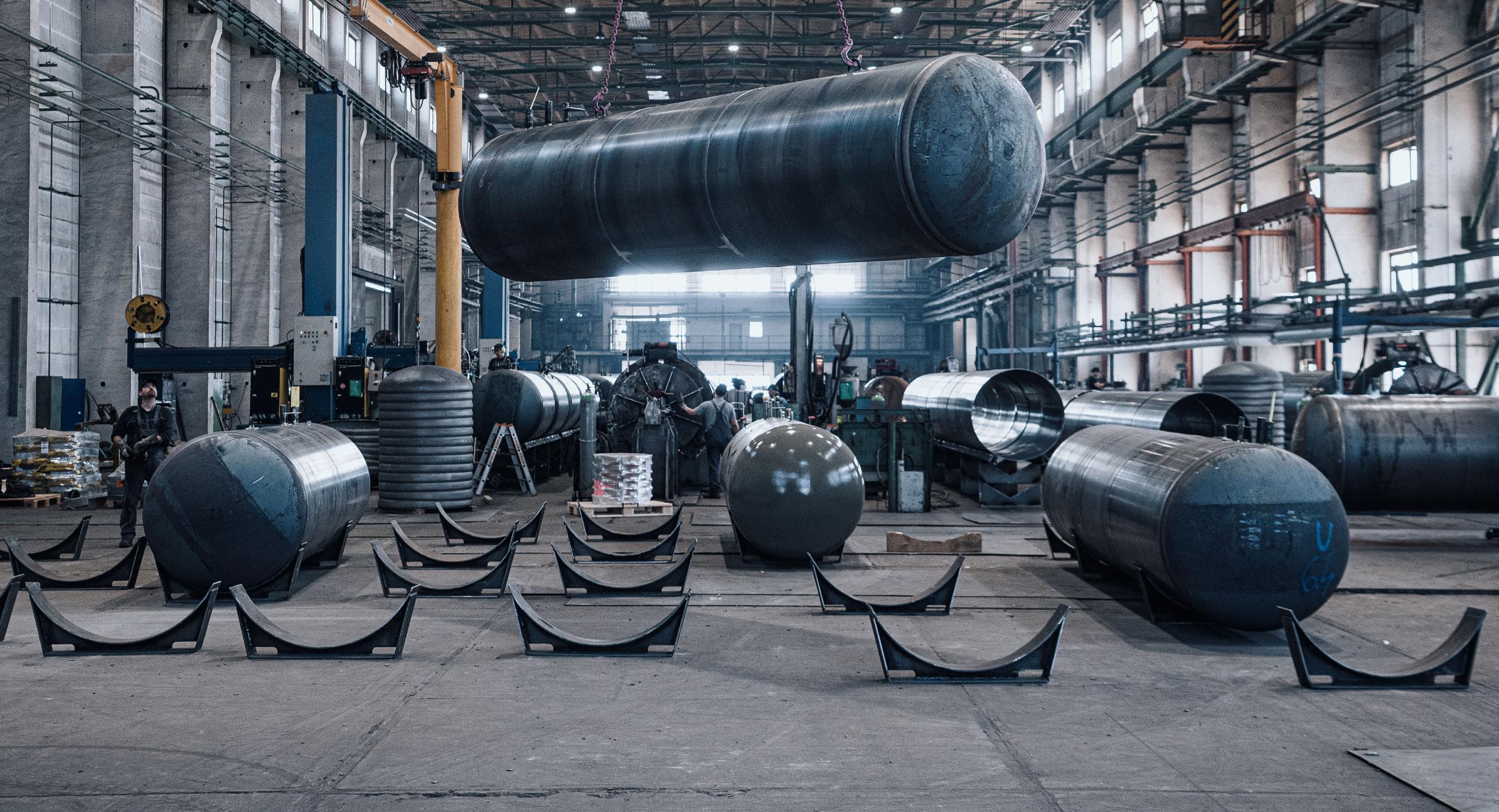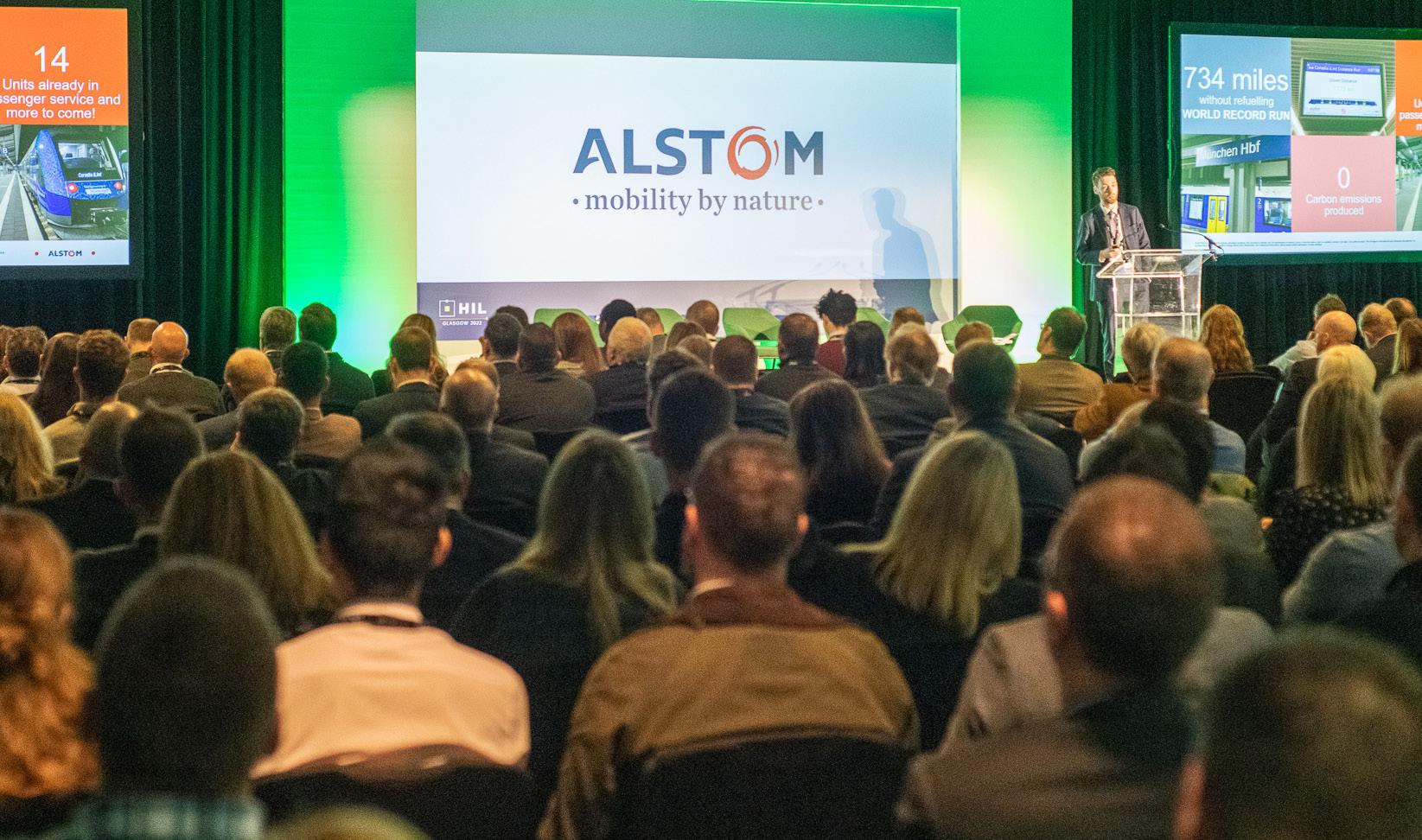CONTENTS
P / 10
Unlocking the True Potential for Hydrogen in Bristol
P / 04
Creating a Global Market for Hydrogen: Certification to Enable Trade
P / 06
Market Share for Hydrogen Electrolysers: Where will the UK be in 2030?

P / 08
Take-or-pay Contracts: Enabling Off-Takers for Green Hydrogen
P / 10
Unlocking the True Potential for Hydrogen in Bristol

P / 18
International Projects
P / 16
Siemens Energy will Enable the Energy Transition

P / 14
Hydra: Providing a Scalable Bulk Rectifier for Green Hydrogen Production
P / 16
Vice President Thoughts: Siemens Energy will Enable the Energy Transition
P / 18
International Projects
P / 20
HIL London Next Up
UNLOCKING THE TRUE POTENTIAL FOR HYDROGEN IN BRISTOL

Bristol plays such an important role in driving the demand case


CREATING A GLOBAL MARKET FOR HYDROGEN: CERTIFICATION TO ENABLE TRADE
In order to create a global hydrogen market, certification models need to be widely and universally implemented so frameworks can be followed and the key pillars in the energy transition can be utilised for maximum impact.
A recent report released by IRENA highlights ways in which certification can be improved and how essential it is for the development of trading hydrogen as a commodity.
The report began: “Certification is an essential element of any trade, especially for the development of a new trade in hydrogen.”
“Certificates for hydrogen and its derivatives would contain information on compliance with standards and regulatory requirements and enable verification through data on sustainability criteria, such as carbon footprint and renewable energy content, thereby allowing differentiation from other less green products.”
Certification allows for compliance on multiple levels
Additionally, certification would also allow compliance with additional environmental, social and governance criteria to be verified and would enable hydrogen consumers to signal the demand for greener products by purchasing hydrogen that is certified as low-carbon or renewable.
IRENA, together with RMI, conducted an assessment of existing certification systems around the world to look for holes within the current process and how this will hinder hydrogen trade across the globe. The assessment was conducted by identifying the key components of a functioning hydrogen certification system
and comparing these components with existing and emerging hydrogen certification mechanisms. Eight voluntary and five mandatory schemes were assessed. Within the executive summary, it was stated that: “This report is a contribution to the work on the G7 Hydrogen Action Pact – specifically on supporting the creation of regulatory frameworks for low-carbon and renewable hydrogen and its derivatives. None of the existing hydrogen certification systems is suitable for cross-border trade.”
Gaps in the standards prove to be a hindrance to hydrogen development
In addition, the report found: “There are gaps in standards and in ecolabelling and certification design, resulting in insufficient information in certificates to allow fair comparison across borders. Significant gaps exist in the following: clear information on greenhouse gas emissions produced during hydrogen production and/or transportation; common standards used; eco-labelling; and compliance with environmental, social and governance criteria.”
Offering a handful of recommendations to fix these bottlenecks, a modular approach to certification at different stages along the supply chain, where each part of the supply chain has its own sustainability criteria scope and thresholds and a single methodology to calculate the emissions intensity of all hydrogen production pathways, building on other schemes, where possible, to address key emissions sources was at the top of the list.
Further recommendations to close the gaps and avoid hydrogen market fragmentation include the need for countries to adopt the following:
• Alignment between accounting methods and policy requirements for additionality, temporal and geographical criteria for hydrogen produced using grid electricity.
• Internationally accepted methodologies to manage the blending of traded hydrogen in order to link production criteria with market requirements.
• Harmonised systems of quality infrastructure for national standards bodies to ensure fairness and accountability of hydrogen certification.
• Establish a process to facilitate mutual recognition between certification schemes for hydrogen and derivatives.
• Think beyond hydrogen and ensure continuity for the hydrogen derivatives most likely to be traded, such as ammonia.
Standards and certification (including design, governance and enforcement operational elements) ensure that the differentiation between rules and validation processes is transparent for both producers and buyers.
IRENA articulated that: “The technical components of a certification scheme are typically embedded in a standard. A standard is an agreed methodology for conducting a process.
“A standard document is agreed upon by experts in national or international settings. Standards are the result of discussion and co-operation between stakeholders – such as manufacturers, sellers, buyers, customers, trade associations, users and regulators –in a determined process.”
In the case of hydrogen, a standard is needed to provide the accounting guidance and criteria to assess renewable or low-carbon credentials.
Source: International Renewable Energy Agency
The minimum technical components that should be present in any renewable or lowcarbon hydrogen standard are outlined in the following sections.
and business model
Ecolabel Standards
Sustainability criteria:
• GHG footprint - scope and threshold
• Accounting guidance (data inputs, quality, measurement type, conversions)
• Other ESG compliance
Scale adoption
Roles and responsibilities of:
• Standard and certification owner
• Certificate issuing body and registry
Data handling protocol
Enforcement mechanism and non-compliance clauses
• Audit and verification based on standard criteria
• Awards certification based on audit
• Quality infrastructure
Chain of custody mode:
• Mass balance
• Book and claim
Digital credit issuing and retirement platform
• Registry
• Tradability
• Credit value
Product service
• Consumer offering (emission reductions)
• Policy and regulation - ambition and integration
• Demand aggregation
• Market engines (normalisation to other metrics)
• Common frameworks (accounting guidance)
• Harmonisation with voluntary corporate standards for emissions accountings (GHG protocol)
ELECTROLYSER MARKET SHARE
MARKET SHARE FOR HYDROGEN ELECTROLYSERS: WHERE WILL THE UK BE IN 2030?
With the UK facing a ‘now or never’ decision on how much of a share in the European market it will have, current trajectories have it facing an equivalent loss of £1.3bn by 2030 if trends continue.
This is echoed in the hydrogen electrolysis share, which fell by 4% in the last two years, according to the CBI and McKinsey research recently published.
With the UK gradually falling behind and struggling to keep pace with the global competitiveness across the electrolyser market and other hydrogen markets, the CBI has advised the UK Government to boost political commitment.
Without further policy, the UK market share for hydrogen will fall
In order to change this, the UK government must introduce new policies and legislative frameworks to enable the scale-up of projects, establish how to trade hydrogen as a commodity and enhance the hydrogen economy in the UK.
The UK has specialist knowledge and innovation capabilities
Looking at the wider net zero agenda, the UK was also found to have far less funding assigned to address climate change when compared to European nations, including France and Germany. Germany has committed over four times as much, and the CBI found France to have committed double.
The table opposite indicates how the UK’s market share has changed over the last two years across the offshore EV battery and hydrogen electrolyser market. With total losses of £4.3bn when including EV assembly by 2030, it is clear to see the potential for the UK to increase its market share.
Total prize losses are estimated at around £4bn
However, this only comes from policy led frameworks stipulating the clear pathway to net zero and the role that hydrogen will play in this. Legislative changes and commitments need to come into force, as other nations are set to increase market share rapidly over the next seven years.
THE UK SHOULD BE WELL PLACED TO CAPTURE THIS ECONOMIC OPPORTUNITY Confederation of British Industry
Outside the UK, the global value of hydrogen electrolysers has been forecasted to be over £22bn. With other European countries lining up their share of the hydrogen pie, time is of the essence to ensure the UK keeps pace.
With the CBI ensuring that the UK isn’t left behind, it is engaging with the UK membership, which equates to almost 25% of private enterprises.
Looking at addressing policy issues is at the heart of the engagement, with hopes to deliver the highest growth route to wider decarbonisation.
Things in place to boost trajectory
- Will the UK use them?
As part of the Green Growth business campaign for 2023, Mckinsey & Co will provide the research and analytical support to make the drastic changes needed and improve the trajectory of market share by 2030.
With attention being firmly focused on securing independent energy security, there is an expectation that this will rapidly change to take advantage of the European export opportunities that hydrogen brings. This could be in the region of £8bn for electrolysers and over £3bn for offshore wind services, something the UK is uniquely positioned to offer by the end of the decade.
The report picked up on this notion, explaining: “In practice, the UK should be well placed to capture a significant proportion of this economic opportunity given its specialist knowledge and innovation capabilities.”
Chances of a turnaround in attitudes towards hydrogen impacts may be limited as the IMF recently announced the UK will be the only major economy to shrink, with an estimated reduction of 0.6%.
While the IMF predicts the UK economy will contract, it forecasts economic growth for the US (1.4%), Germany (0.1%) and France (0.7%).
Elsewhere, schemes such as REPowerEU have set out plans to diversify their supplies of clean energy, with hydrogen high up on the agenda for this. In a package delivering over €300bn of funds for projects, solar, wind and hydrogen market shares are expected to increase across the EU.
America is set to become the largest exporter of hydrogen as it stands
Across the Atlantic, the widely reported Inflation Reduction Act is a globally leading package of support for energy security. With $370bn planned support over the next decade, the rest of Europe has a challenge in competing for the world’s leading export status, the UK could play a huge role in this.
Despite this, the CBI also found that the transition is already worth £71bn to the UK and has 840,000 current jobs linked to the ‘green’ sector. With the average wage in the sector just under £10,000 more than the national average, there is encouragement that more people will transition into the sector and boost productivity.
OFFTAKERS
TAKE-OR-PAY CONTRACTS: ENABLING OFF-TAKERS FOR GREEN HYDROGEN
Establishing off-takers for hydrogen is one of the current bottlenecks hindering the development of hydrogen projects globally, notably in the UK. With recent reports from the IEA stating less than 10 per cent of projects reach final investment decisions, what can the hydrogen sector learn from the LNG market?
With the LNG market being wellestablished globally, it is natural to compare the embryonic hydrogen offtake market when looking at how to secure the hydrogen economy moving forwards.
owner of the electrolyser to convert the water into hydrogen and oxygen.
In contrast, the sale-and-purchase model requires the project to either produce or purchase the upstream gas and is responsible across the supply chain from transporting it to the facility liquefying the gas and selling it as an LNG.
Putting this in green hydrogen terms, a project developer would buy electricity and water. As with natural gas, the electrolyser facility owner may procure
THAN 10 PER CENT OF PROJECTS REACH FINAL INVESTMENT DECISIONS
LNG and Hydrogen contracts to follow similar route as it stands
Over the years, LNG projects have developed two principal revenue contract models: tolling agreements and sale-andpurchase agreements.
Through tolling models, LNG facilities provide capacity to their customers, meaning each customer is responsible for sourcing natural gas, delivering it to the facility, shipping etc. Essentially, the customer pays the liquefication to convert gas belonging to the customer into LNG.
Focussing on how this would look for green hydrogen, the customer would purchase electricity to be used at the electrolysis plant and potentially also supply the water to be used. It would supply these raw materials and pay the
electricity in several ways. This could be through a third party, including a corporate PPA. Additionally, electricity can be purchased in the spot market, but the PPA is used as a means to fix the price.
Determining which is the best model to use includes multiple factors and differs from project to project. This is one of the reasons why it is difficult to establish, but the considerations include the availability and terms of a PPA or other feedstock supply agreement will be better for the entity with a higher credit rating, and different counterparties will be differently disposed to enter into a separate PPA or other energy supply arrangement or to procure the water necessary for a green hydrogen project.
LESS
Pricing for hydrogen is one of the biggest conundrums facing the sector
Offtake contracts will be looking for reliable and predictable revenue streams to unlock the hydrogen economy. With this in mind, the sector can expect to see a mixture of take-or-pay and take-and-pay contracts appearing to secure the finances involved.

Take-or-pay contracts expected to be popular in early stages
Take-or-pay, as it sounds, would require the buyer and seller to agree on a preestablished quantity of hydrogen to be delivered, in which the buyer would have to take the quantity or pay for the amount not taken. These methods are common in the LNG sector as the buyer can make up for failure to take at periods of high demand, as long as it has been paid for in the tale-or-pay agreement.
Slightly different, the take-and-pay contract ensures the buyer must take the total delivery that was pre-agreed, with failure to take resulting in the seller qualifying for remedies for the breach. Unless the contract provides for liquidated damages, seeking recovery for the breach takes time and considerable effort, as the seller has to demonstrate efforts to reduce losses and proof of loss.
‘Bankable’ green hydrogen still a way off as supply grows
In the early stages, with varying supply and demand, the sector can expect take-or-pay contracts to be more popular, then take-andpay continuing to grow as the supply grows.
Sorting out pricing for hydrogen is one of the biggest conundrums facing the sector, especially as there are no current spot prices for hydrogen. Current sales of hydrogen are tightly linked to the price of feedstock due to the vast majority of hydrogen produced currently being derived from fossil fuels.
Addressing all these core issues will help hydrogen to be traded as a commodity, scale up production and ease current bottlenecks. Until this benchmark is reached, green and blue prices are set to follow a similar formula to grey, based on fixed costs and variable costs.
For the sector to establish whether hydrogen is ‘bankable,’ offtake contracts will most likely use these two types of contracts. Reasons being:
1 | Financiers will require a predictable revenue stream to ensure protection and profits.
2 | Because there is no merchant market for hydrogen, selling hydrogen not taken and paid for by a customer will be an extremely difficult proposition.
3 | Early projects will have constant input costs, and an unreliable purchaser of the output will reduce project final investment decisions, particularly in electricity use under PPAs.
UNLOCKING POTENTIAL
UNLOCKING THE TRUE POTENTIAL FOR HYDROGEN IN BRISTOL
If the UK is to unlock the full potential that hydrogen can bring the economy, maximising the cluster of projects and hubs across the country is vital; with Bristol being no exception to the rule.

Focusing on the aviation sector, Bristol is uniquely placed to be the home of an Airport Hydrogen Hub, which has been determined by a new partnership of Airbus, easyJet, and EDF’s Hynamics. This UK project now joins a network of ‘ZEROe’ agreements that Airbus has reached with various airports in Europe and Asia Pacific to explore hydrogen technology.
The project brings together a network of hydrogen experts to assess the local and global hydrogen supply chains, forecast future hydrogen powered aircraft traffic, and explore how a hydrogen supply at Bristol Airport could also power other forms of transport, such as HGVs and other heavy vehicles.
Sector Collaboration at the heart of the project
By bringing together the Airport, the airline easyJet, manufacturer Airbus, and hydrogen generator Hynamics, the project creates a unique partnership to assess how hydrogen technology can be best used under ‘real world’ conditions. The project is one of several being taken forward as part of Hydrogen South West, a cross-sector consortium of companies that is working to develop a hydrogen economy in our region.
Glenn Llewellyn, VP - Zero Emission Aircraft, Airbus, said: “Having a range of different airport projects like this is vital preparation for the arrival of our Zero Emission Aircraft from 2035. It’s exciting for us to collaborate and learn with valued partners in this project as part of a dynamic UK hydrogen ecosystem.”
South West England is home to a significant aerospace and aviation cluster providing around 100,000 jobs. Bringing forward zero emission technology for flight would cut global emissions, secure the long-term future of the sector, and create thousands of new green jobs. The future for sustainable aviation is yet to be determined

Airbus plan to produce the world’s first zero-emissions commercial aircraft by 2035. A modified Airbus A380 ZEROe demonstrator with a hydrogen-powered engine is expected to begin test flights in 2026. At Filton, Airbus is developing a Zero Emission Development Centre (ZEDC) for hydrogen technologies, including the development of a cost-competitive cryogenic fuel system.
Last month, easyJet announced an ambitious roadmap to achieve net zero carbon emissions by 2050, with hydrogen playing a key role. With Rolls-Royce, the airline will shortly begin ground testing of hydrogen-powered engines.
Jane Ashton, Sustainability Director, easyJet, said: “At easyJet, we are committed to working towards a future with zero carbon emission flying. We know that technology is a key driver to achieve our decarbonisation
targets, with hydrogen propulsion expected to be critical for short-haul airlines like easyJet. This partnership will provide vital lessons on how the fuel can be used in the real world and builds on our strong relationship with Bristol Airport.”
Hynamics, a subsidiary of EDF, are specialists in low carbon hydrogen production by water electrolysis in France, Germany, and across the United Kingdom. Bristol Airport is making itself available as a testbed for new technology, as part of efforts to cut emissions from flights after its own operations become net zero by 2030.
Simon Earles, Director of Sustainability and Corporate Affairs, Bristol Airport, said: “Bristol Airport is delighted to be joining the ranks of prestigious airports around the world in working with Airbus to deliver zero emissions flight. We’re committed to leading on sustainability and opening ourselves up as a testbed for new technology.”
This partnership will provide vital lessons on how the fuel can be used in the real world and builds on our strong relationship with Bristol Airport.
Jane Ashton Sustainability Director easyJet


Manchester
22 September 2023
Durham

09 June 2023
Bristol
24 March 2023
Hull
01 December 2023
New for 2023, the HIL 100 Breakfast Hub will offer a series of regionally focussed network opportunities and a chance for stakeholders and suppliers to discuss key projects and pilots within the regions we cover.



These breakfast events will provide a touchpoint for the industry to collaborate, share best practices, and outline the role hydrogen will play in a net zero society.

Accelerate your business with HIL networking events
#H2Leaders
hydrogenindustryleaders.com
SCALABLE BULK RECTIFIER
HYDRA: PROVIDING A SCALABLE BULK RECTIFIER FOR GREEN HYDROGEN PRODUCTION
Scalability is one of the hottest topics in the hydrogen sector as we establish the supply chain around how hydrogen will be produced, stored and distributed. Focusing on R&D and future-proofing are often at the heart of unlocking this potential, and Prodrive Technologies have utilised this through its Hydra scalable bulk rectifier for green hydrogen production.
Working together with trusted partners, Prodrive Technologies has developed the Hydra rectifier system, featuring its SiCbased unique power converter technology. This provides an efficient and scalable solution for electrolyser manufacturers that is easily integrated and can be scaled up as a repeatable unit up to GW-scale capacity.
Silicon Carbide-based converters improve efficiency, as well as AC and DC current quality, without the need for external filters. The input can be connected to any medium-voltage AC by varying the MV to LV stepdown transformer, keeping the rest of the system standardised. The output supplies the DC voltage and current that the OEM or stack builder requires for their specific stack design. The Hydra is designed to inherently comply with grid codes, so external filters and compensation banks for incoming current are not needed.
The Hydra rectifier cabinets can be integrated into a containerised solution or on a skid, depending on customer requirements. The solution includes its own closed-loop liquid cooling system. The integrated solution is designed to maximise uptime by minimising maintenance. This allows green power to be utilised 24/7, whenever it is available and reduces ongoing costs compared to air-cooled solutions.
R&D is integral to scalability of green hydrogen production
Starting off by explaining how R&D is essential, Wouter van Gennip, Commercial Director at Prodrive Technologies, said: “We hire around 2500 people, with over 50 per cent of the workforce working on research and development. This means we are developing the projects rather than only manufacturing them. Putting ourselves at the heart of projects allows us to be at the forefront of the innovation behind scaling up hydrogen production.”
Focussing on how the unique power converter technology provides a more efficient and scalable solution, Wouter explained: “The core aspect to scalability is modularity. For us, we are using a 200 kW module that is in a rack, which can be combined into a containerised solution and scaled from there up to GW scale.
Hydra offers standardisation and dynamic range
For Wouter, the two keywords around scalability include standardisation and dynamic range: “Considering both these aspects allows for our equipment to be used anywhere, mainly across the US and Europe for now, and progress towards the equator.”
Different regions naturally have varying grid and environmental conditions, so in order to be scalable, you need a solution, such as the Hydra system, that can deal with unique conditions. Another factor to consider is that the mid-voltage each region has is converted to an input voltage that the equipment can handle.
Wouter expanded on this: “we have the flexibility within the transformer, which
is easy to handle. Our system can solve this, which allows us to expand with the standardised system in mind.”
Scalability is an essential aspect of delivering more capacity, but Wouter also told Hydrogen Industry Leaders: “future-proofing is just as important. The voltage for stacks is currently sporadic in a range from 50 volts to 1500 volts. A lot of companies are around 400-600 volts which are fine for now but taking into account the lifetime of the project and the lifetime of the stacks; they typically won’t overlap very well.”
The sector must plan for more efficiency by 2030
With all the innovation going on, it is expected that the stack efficiency will be dramatically improved by the time the lifecycle of current stacks comes to an end. This means that by 2030 you won’t be replacing stacks like for like, so the
system has to be adaptable to this today for implementation in the future.
Prodrive Technologies have flexibility on the mid-voltage side of things and the different stacks the system can handle, which uniquely positions the Hydra project above others. “We can easily scale to the right size of the customers’ needs today, but also upgradable to what they will need in the future,” Wouter added.
Expanding on the efficiency angle, the Hydra doesn’t require the use of filters, something which hampers efficiency between 1-2% ordinarily. Finally, Wouter said: “Operating at low total harmonic distortion helps with efficiency, and this offers a sum of efficiency that is considerably higher than other products. For example, at 1200Vdc, we are now at a peak efficiency of 98.4% grid-to-stack, which includes the transformer, the rectifier and the whole chain involved.”
 Source: Prodrive Technologies
Source: Prodrive Technologies
“
EXCLUSIVE INTERVIEW
VICE PRESIDENT THOUGHTS: SIEMENS ENERGY WILL ENABLE THE ENERGY TRANSITION
By Chelsea BaileyTo balance intermittent renewables and increase the usage of green energy, Siemens Energy and SSE are set to develop plans to integrate hydrogen production, storage, and power generation technologies at a project in the Humber region.
The Aldbrough Hydrogen Pathfinder project will support the evidence base for the wider deployment of flexible hydrogen power in the UK’s net zero journey and aims to produce hydrogen and start filling the cavern by 2025, subject to planning consents and reaching a financial investment decision next year.
Located at SSE Thermal and Equinor’s existing Aldbrough Gas Storage site on the East Yorkshire coast, the project is designed to demonstrate the interactions between hydrogen electrolysis, hydrogen cavern storage and 100 per cent hydrogen dispatchable power.
Siemens energy is showing how technology can support net zero transition
It could see green power sourced from the grid through Renewable PPAs, in compliance with the Low Carbon Hydrogen Standard. Hydrogen would then be produced via a 35MW electrolyser before being stored in a converted salt cavern and then used in a 100 per cent hydrogen-fired turbine, exporting flexible green power back to the grid at times of system need.
Hydrogen Industry Leaders spoke to Steve Scrimshaw, Vice President at Siemens Energy Limited UK & Ireland, about the Aldbrough Hydrogen Pathfinder project and its importance.

He said: “As Technology Partner, the project involves Siemens Energy providing an electrolyser, which converts green electricity into hydrogen and oxygen. We will compress the hydrogen into a salt cavern, which is storing gas at the moment, but that would be changed to create and store hydrogen there.”
These caverns at Aldbrough were created more than a decade ago out of a subterranean layer of rock salt and are used to store gas at times of low demand and sell it back at peak demand periods. The project is seeking support from the UK Government’s Net Zero Hydrogen Fund, which aims to support the commercial deployment of new low-carbon hydrogen production projects during the 2020s.
Steve revealed how necessary funding like this is: “This project has been entered into the Net Zero Hydrogen Fund competition. We’re looking forward to hopefully seeing the government supporting it, and then we can get this underway. I think the more we get forward in doing some of these things, we will create a strong hydrogen economy, which is important for the UK.”
I think this will be a trailblazer to demonstrate that there is a technology that can be used for intermittency.
Steve Scrimshaw
Vice President Siemens Energy
Pace and clarity are key to hydrogen projects being delivered
For the UK to deliver on its net zero ambitions, the following year can either pave the way for crucial final investment decisions or result in that capital being used elsewhere. Providing clarity on business models for the infrastructure required to deliver and turn targets into a defined policy is essential.
Steve explained that boosting confidence in the hydrogen economy is crucial: “I think you need to build up momentum behind it. You will find that investors and people have confidence that things are happening because there is a lot of talk in the industry.”
Everybody is just waiting for the hydrogen business models, and building that confidence is essential.
Steve Scrimshaw Vice President Siemens EnergyTo boost this confidence, projects need to be delivered and to deliver these projects, a quick pace is critical: “We need to get this moving quickly so that we can provide it. Getting this down and working will be a massive challenge, but that is the thing for us as a country.
“At the moment, as a country, we have got a process that we’re going through, and I think we need to move at a quick pace to try and get some industrial projects, not just demonstrated, but deployed at scale.” Steve expressed.
The project is a key element to decarbonising the humber
In the future, Steve revealed that Siemens Energy wants to continue to empower its customers to meet the growing global demand for energy while transitioning to a more sustainable world: “We connect the wind farms offshore with big transmission projects, we make grid connections for electrolysers, we make electrolysers, we make gas turbines that produce energy, and a lot of this is in the UK.
“We have got around 4000 people in the UK, multiple factories, and we’re involved in many carbon capture projects in the UK.”
The Aldbrough Hydrogen Pathfinder project is forming a key element of more comprehensive plans to decarbonise the Humber, which is currently the UK’s most carbon-intensive industrial cluster.
Developing carbon capture usage and storage and low carbon hydrogen technology, shared with regional infrastructure, would help to preserve jobs by enabling energy-intensive industries to continue to operate and thrive whilst decarbonising the UK.
Through this technology and infrastructure, the Humber can become the base for the UK’s first net zero carbon industrial region. Siemens Energy is confident that being across the value chain uniquely positions them as enablers of the energy transition.

INTERNATIONAL PROJECTS
HYDROGEN PROJECTS FROM AROUND THE WORLD
Germany
It has been revealed that Germany will be joining the H2Med project alongside Spain, France, and Portugal.
The new project called H2Med aims to bring hydrogen produced from renewable sources in Spain and Portugal to the rest of Europe through an undersea pipeline. It is working to reduce Europe’s dependence on Russian energy and is helping to make the transition to cleaner energy sources.
Spain, France, and Portugal agreed in December 2022 to build the pipeline by 2030, and now Germany has joined the project.
Running from the port of Barcelona to Marseille, hydrogen made from water via electrolysis will be transported, a process which uses renewable energy.
The Spanish Government has estimated that the pipeline will be able to supply 2 million metric tonnes of hydrogen to France annually, which is about 10 per cent of the EU’s estimated hydrogen needs.
Azerbaijan
The State Oil Company of the Republic of Azerbaijan (SOCAR) and the United Arab Emirates’ Masdar have entered into a partnership on offshore wind and green hydrogen projects in Azerbaijan.
Under a joint development agreement, SOCAR and Masdar will together develop offshore wind and hydrogen production projects totalling 2 GW in capacity.
In addition, the two companies have also signed joint development agreements on 1 GW of solar PV projects and 1 GW of onshore wind.
According to SOCAR, the agreements will contribute to continuing the strengthening of the cooperation between the Republic of Azerbaijan and the United Arab Emirates.
The agreements on 1 GW of solar and 1 GW of onshore wind projects also build upon the cooperation agreements signed between the government and the UAE company in June.
China
Topsoe and Mintal Hydrogen Energy Technology have revealed they are set to develop a green ammonia PtX plant in China.
Mintal Hydrogen has chosen Topsoe as its technology partner for the project in Baotou, which is set to begin production in 2025.
It is claimed by the companies that this is the first dynamic green hydrogen plant in China, with a first-phase capacity of 1,800 tonnes of green ammonia per day, and 390,000 tonnes annually.
The green ammonia produced is expected to replace approximately 850,000 tonnes of coal and reduce more than 2 million tonnes of carbon dioxide from being emitted annually.
Providing dynamic ammonia technology to secure optimal production and adapt to the inherent fluctuations in power output from wind turbines, the plant will be Topsoe’s first PtX plant in China.
Topsoe and Mintal Hydrogen’s proposed plant will align with the Industrial Sector Peak Carbon Implementation Plan, which aims to substitute hydrogen from coal for hydrogen from electrolysis powered by IRE.
Poland
Metacon has signed a MoU with the Regional Directorate of State Forests (RDSF) in Katowice, Poland for a 5MW green hydrogen project.
The pilot project is planned for this year, with hydrogen production expected to begin in early 2024, with a 5MW electrolyser linked to a planned RDSF solar PV installation Katowice will be seen.
Metacon will be supplying electrolyser equipment and turnkey infrastructure, and the PV system will be owned and operated by RDSF.
This MoU is part of RDSF’s development project ‘forests of energy’ which is targeting investments in fossil-free energy and hydrogen. Also, it will begin the construction of several facilities for green hydrogen production for the transportation sector.
It follows last year when Metacon revealed that it is set to supply an integrated green hydrogen production, storage, fuel cell and refuelling system to Romanian firm, Ground Investment Corp, under a €16.1m agreement.



